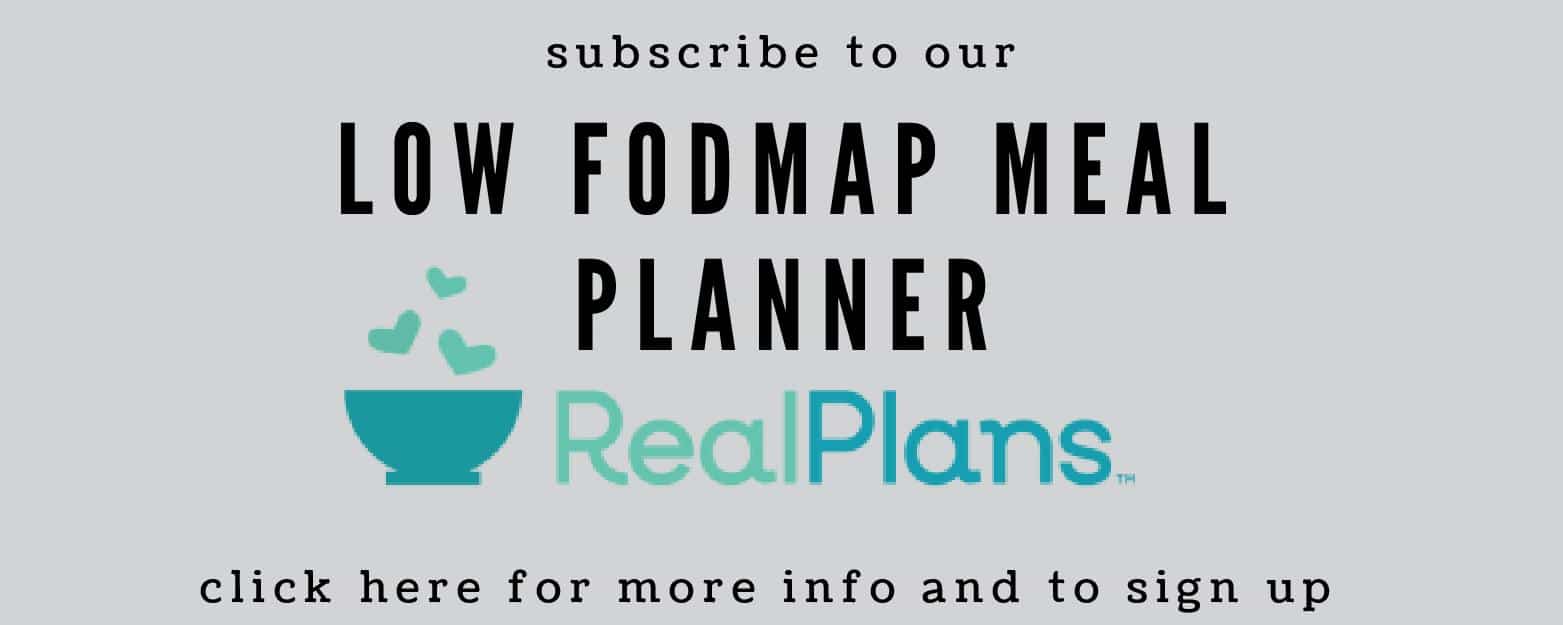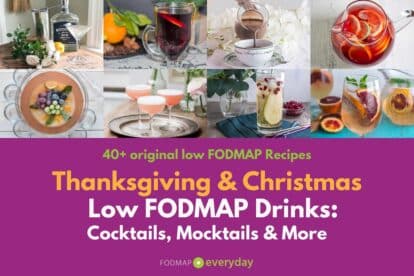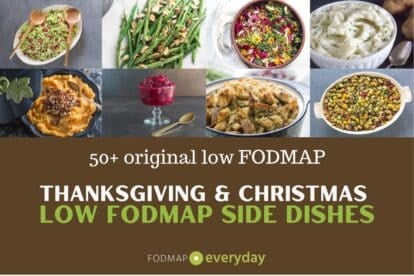When you first learn about the low FODMAP diet, the idea that you should avoid garlic and onion comes up pretty quickly. We bet the title of this article took you by surprise. The easiest way to think about this is that the diet is low in FODMAPs, but not completely devoid of FODMAPs.
The diet is very much serving size dependent, and you will learn that there are many foods that are often referred to as high FODMAP that actually have low FODMAP serving sizes. Garlic and several types of alliums (onions) are such ingredients, and this article explains how you can have some types and amounts of garlic and onions incorporated into your low FODMAP diet, even during the most restrictive Elimination Phase.
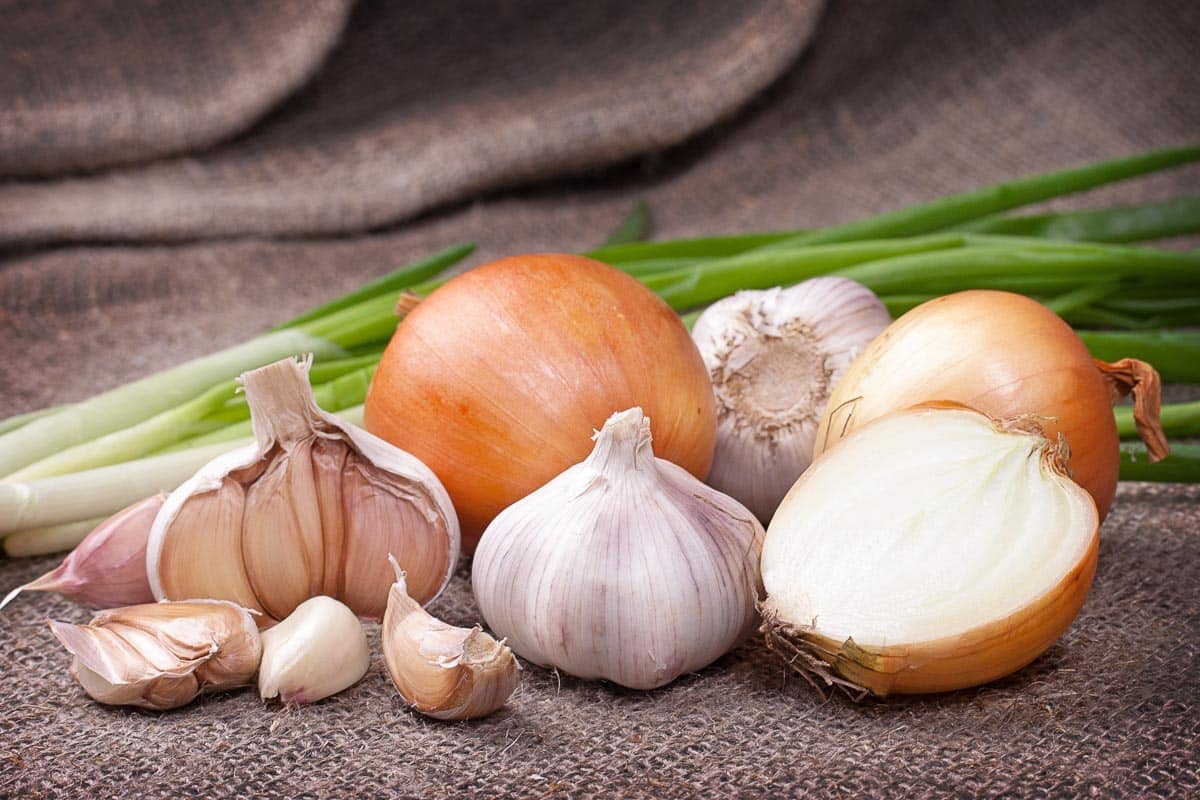
- Why Are Garlic & Onions IBS Triggers?
- Fructans Are Reduced During The Elimination Phase
- Fructan Thresholds Count
- Let’s Look At What We Can Eat
- Garlic & Black Garlic
- White Onions, Yellow Onions, Red Onions, Vidalia Onions & Shallots
- Scallion, Green Onion, and Spring Onions
- Chives & Asian Chives
- Leeks
- Ramps
- More On Garlic & Onions
- The Takeaway
Why Are Garlic & Onions IBS Triggers?

Fructans, which are part of the “O” (oligosaccharides) in the acronym FODMAP, are found in garlic, onions, as well as wheat, oats, many vegetables as well as other ingredients. They are also the FODMAP that statistically trigger IBS (irritable bowel syndrome) symptoms the most.
Oligosaccharides are not absorbed by humans whether they have IBS or not because we lack the enzymes needed to break the bonds between the chains that make up these molecules. Instead of being absorbed and used as fuel, oligosaccharides travel through the small intestine to the large intestine where they are fermented by bacteria, which leads to IBS symptoms.
Most of us have friends or family members who have always said, “oh, garlic/onions don’t agree with me,” and these are people who do not even have an IBS diagnosis.
Fructans Are Reduced During The Elimination Phase
During the Elimination Phase we are greatly reducing the amount of FODMAPs we are ingesting – including those pesky fructans. This allows our digestive system to calm down and to provide a clean slate, as it were, for the Challenge Phase ahead.
One of the things we see again and again is folks not conducting a well-structured Elimination and Challenge Phase. Note that we said “structured” and not “strict”. Some people do better with a Gentle Low FODMAP Diet approach, but any which way, it should be structured so that you are gathering real data about how you react to foods.
Many people find that eventually they can bring garlic and/or onion back into their diet, in certain amounts, and not trigger IBS symptoms.
The lab tests are guides; they are not absolutes. The amounts are not guaranteed to not trigger symptoms. They are a place for you to begin to explore your unique relationship to FODMAPs.
Fructan Thresholds Count

It most often comes down to the amounts of garlic or onion that are eaten. In scientific terms, FODMAP researchers look at thresholds. They have determined, in clinical tests, how much fructan can be ingested, before IBS symptoms are triggered, in most people. You might not be “average”. We all have unique gastrointestinal tracts.
This is a very important point to remember: the lab tests are guides; they are not absolutes. The amounts are not guaranteed to not trigger symptoms. They are a place for you to begin to explore your unique relationship to FODMAPs.
Let’s Look At What We Can Eat
As promised in the title, there are amounts of garlic and onion that are considered low FODMAP. Let’s take a look:
Garlic & Black Garlic
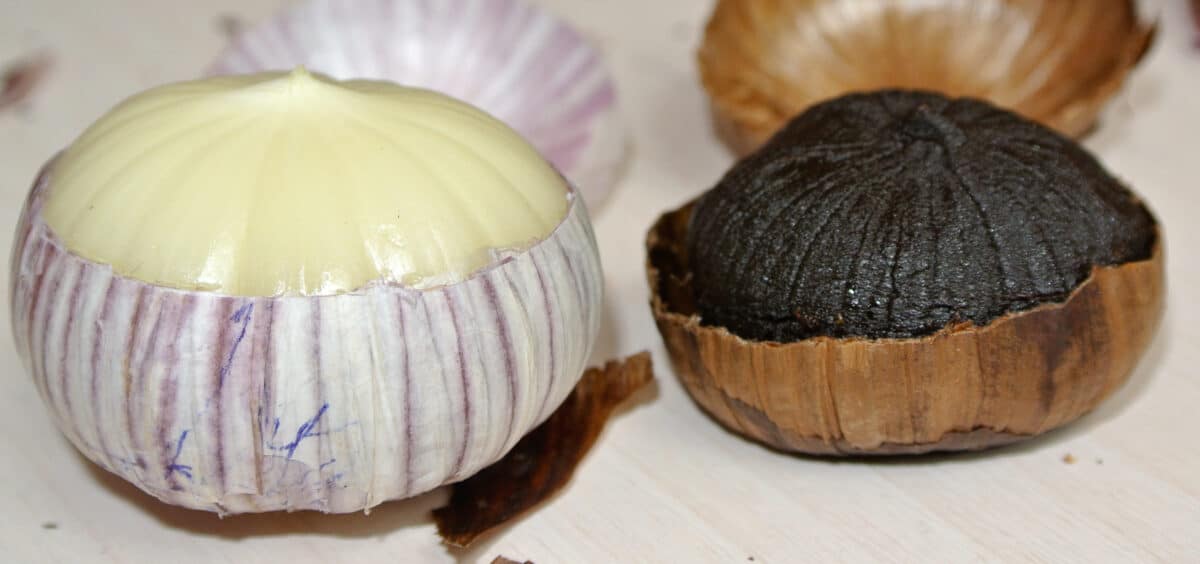
Monash University las lab tested both conventional garlic and black garlic and both have lab tested as high FODMAP. For a deeper dive into this beloved cooking ingredient, please refer to our article, Explore An Ingredient: Garlic. Note that they did not lab test servings as small as FODMAP Friendly. Please read the next section.
FODMAP Friendly has lab tested conventional garlic and they have found that 1 g of fresh garlic is low FODMAP. This makes sense as there are products that have been lab tested and certified low FODMAP that contain small amounts of garlic, such as Sriracha and Worcestershire sauce. Please read our article on How To Use The FODMAP Friendly App to learn more.
Is Pickled Garlic Low FODMAP?
Yes, pickled garlic is low FODMAP, and has been lab tested by both Monash University and FODMAP Friendly.
Monash lab testing shows a low FODMAP serving size to be 3 g, but not becoming moderate for FODMAPs until 29 g.
FODMAP Friendly lab testing shows a low FODMAP serving size to be 5 g, with a max low FODMAP serving of 17 g.
White Onions, Yellow Onions, Red Onions, Vidalia Onions & Shallots
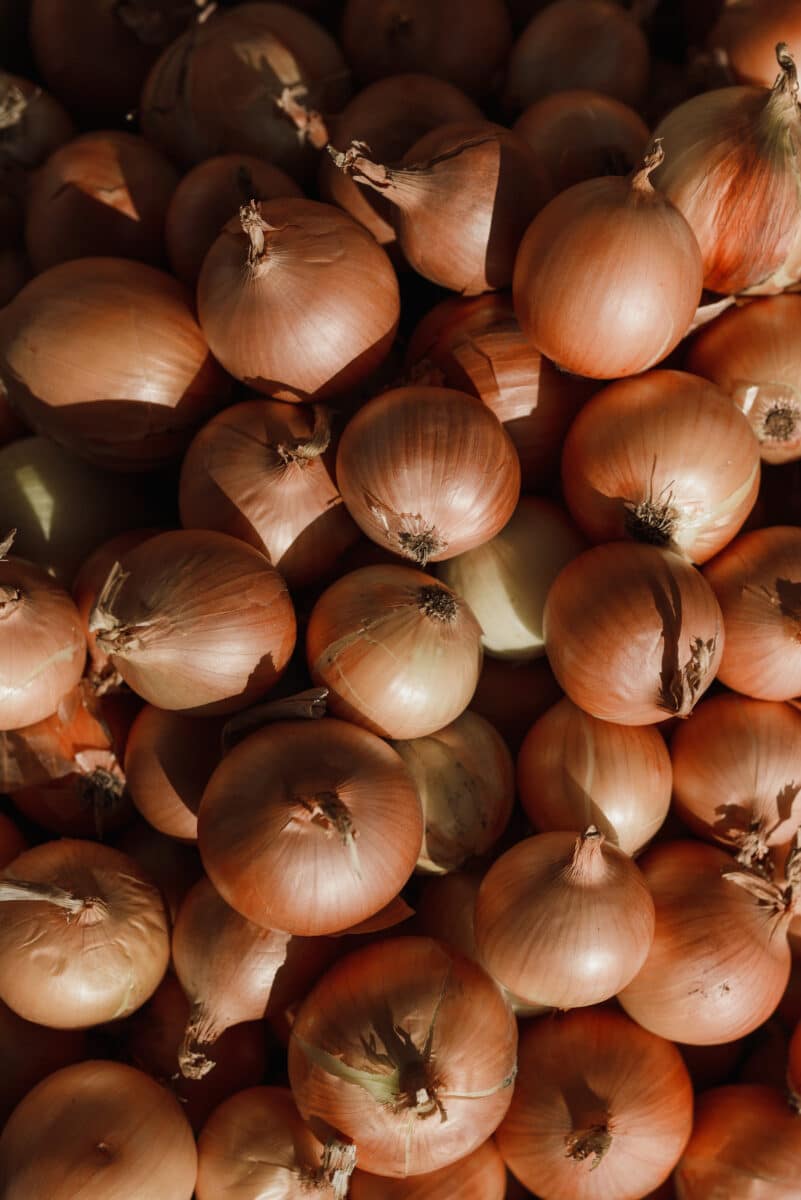
Yellow/brown onions have been lab tested by FODMAP Friendly. A 26 g serving is low FODMAP, but they become high FODMAP quickly at 30 g.
Monash University has lab tested red onions, also called Spanish onions and a low FODMAP serving size is 10 g. FODMAP Friendly’s low FODMAP serving is 27 g.
Monash has lab tested Vidalia onions and 22g are low FODMAP.
Shallots are oval in shape; their skins and flesh can be pinkish-red or just have hints of color, as seen here.
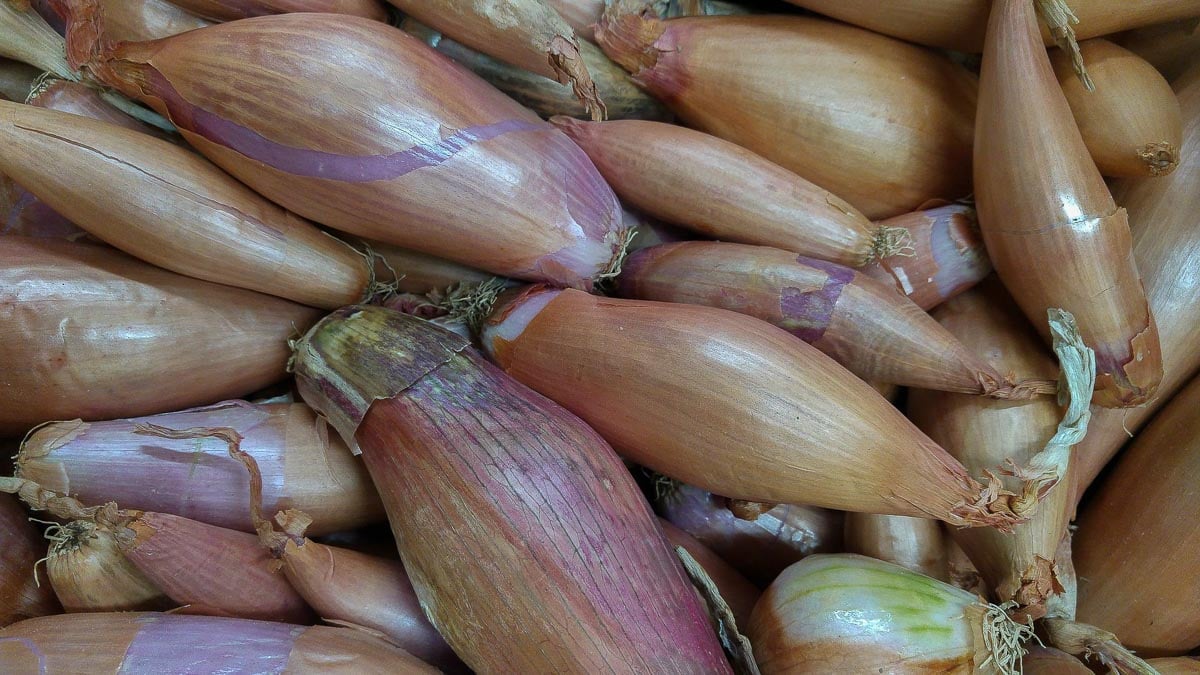
Monash University lab tested shallots, but found no low FODMAP serving, but they tested large amounts.
FODMAP Friendly have lab tested shallots and 1 g is low FODMAP.
Are Pickled Onions Low FODMAP?
Both Monash University and FODMAP Friendly have lab tested larger pickled onions, as well as small. It is thought that the fructans, which are water soluble, leach into the pickling liquid, so we recommend eating the pickled onions drained.
Monash University lab testing shows large onions pickled in vinegar to have a low FODMAP serving size of 45 g (updated to 60 g). Serving sizes over 107 g will be high in fructans. They sourced small, pickled onions in Germany and initially no low FODMAP serving size was found; subsequently, a low FODMAP serving of 3 g was determined. (BTW, they are high in fructose, not fructans. Processing of foods can, and often will, alter FODMAP content).
FODMAP Friendly lab testing showed larger pickled onions to be low FODMAP in 30 g portions, with a low FODMAP max serving size of 43 g. Small pickled onions were shown to be low FODMAP in 30 g portions with a low FODMAP max serving size of 58 g. The app entry for small, pickled onions has been removed, and the “large” pickled onions are now just called “pickled onions.”
Scallion, Green Onion, and Spring Onions
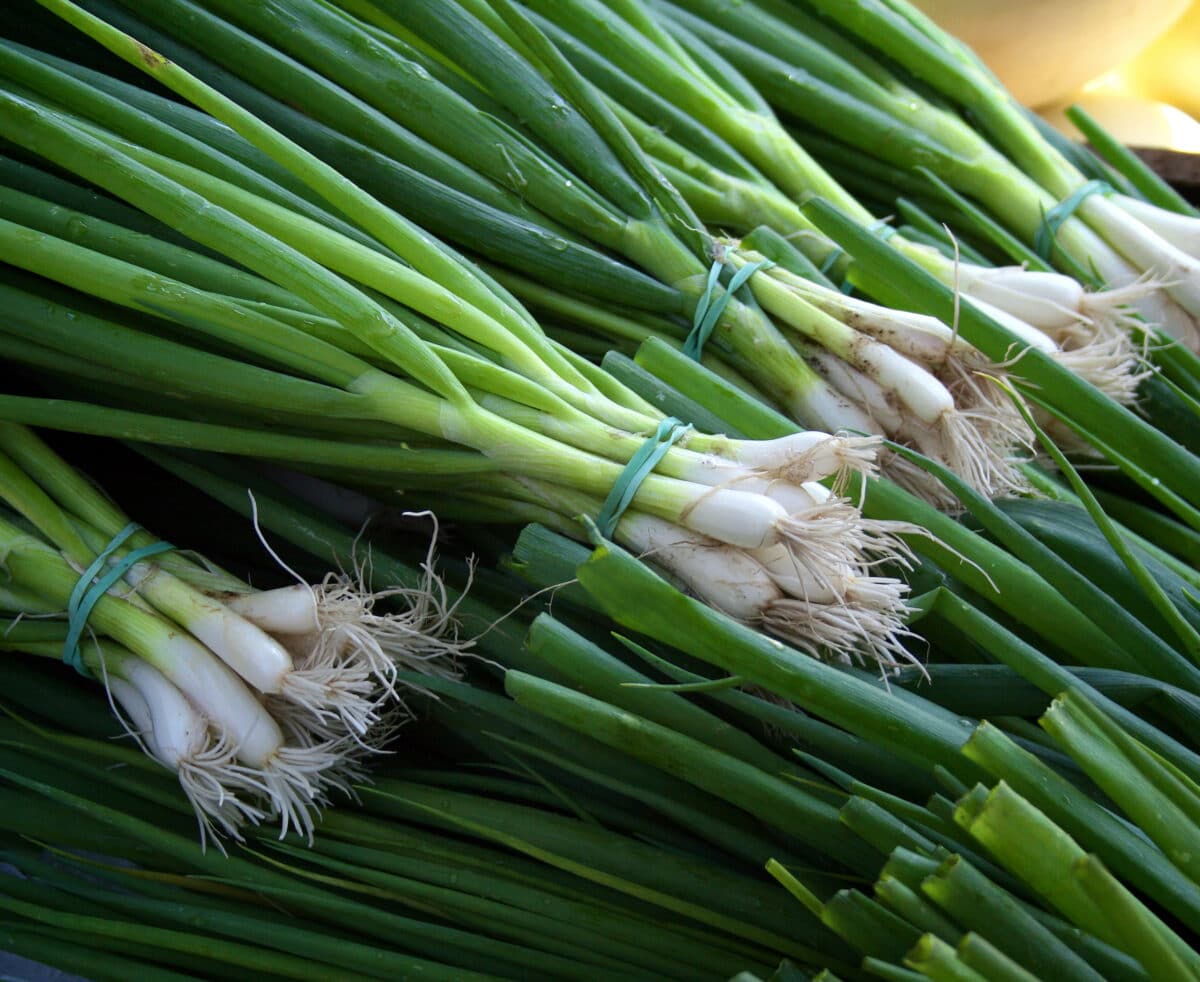
Monash University lists spring onions and scallions as the same thing, but they are not considered the same in every part of the world. In the UK and Canada, and apparently Australia, they are all Allium fistulosum.
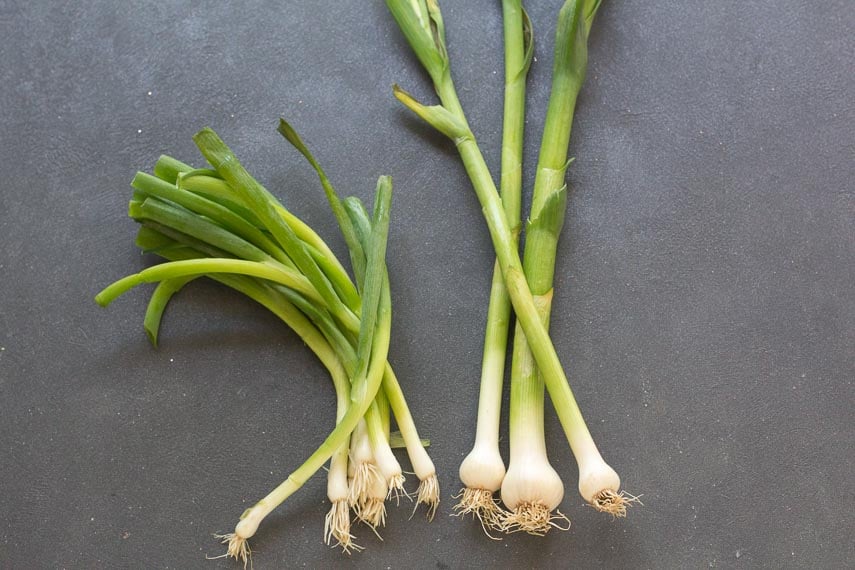
In the U.S., scallions and green onions are considered the same thing, but spring onions are a different variety of allium. Our spring onions are a variety that grows a pronounced bulb, as seen in the image below.
Since we know that different varieties of produce can have vastly different FODMAP content (just look at bananas, peppers, cabbage, to name a few), we suggest tucking this knowledge away, sticking with mostly the green parts of these vegetables, and assessing your own tolerance.
Please review our article, When Low FODMAP Lab Test Results Differ; it is one of the most important articles that you can read. Varied FODMAP content has been found upon different testing batches, which is to be expected.
Monash University lists scallion bulb as low FODMAP in 32 g portions. Scallion greens are low FODMAP in 75 g servings, becoming Moderate for FODMAPs at 97 g, however, please note that in some tests, they showed no FODMAP content whatsoever.
FODMAP Friendly lists scallion bulb with a 20 g low FODMAP serving. Scallion greens are low FODMAP in 16 g servings, with a max low FODMAP serve of 176 g, updated to 160. (See the difference from the Spring onions, below).
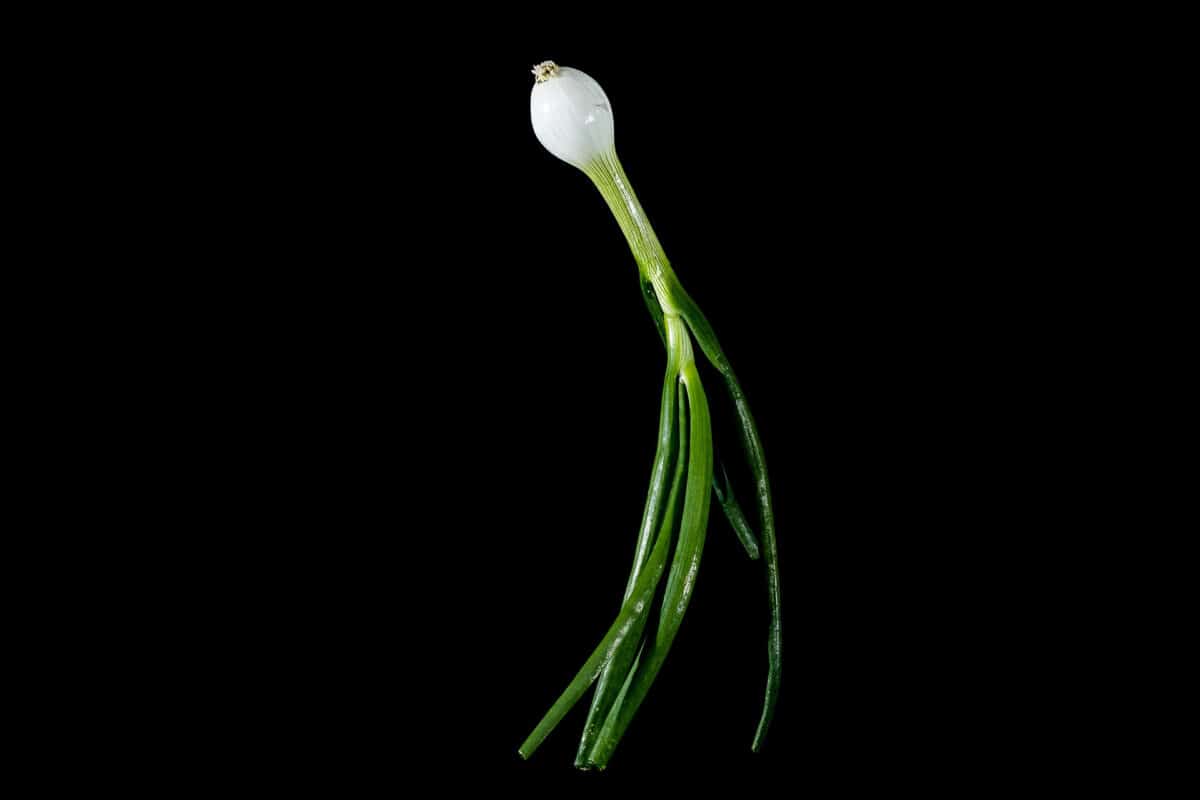
BTW, spring onions are also known as Welsh onion, Japanese bunching onion, bunching onion, and long green onion.
Thankfully, FODMAP Friendly DOES have separate entries for scallions and Spring onions. Their Spring onion bulbs have a 20 g FODMAP serving size, and the greens are low FODMAP up to 48 g; updated to 40 g.
How Do I Use Green Onion Tops? How Do I Use Scallion Greens?
Whether you call them scallions or green onions, scallion greens or tops, it is very easy to use the green parts to add onion flavor to your low FODMAP cooking. Simply rinse with cool water, dry and chop. They can be used any way you would have used onions in your pre-FODMAP days. Sauté them; use raw as garnish, etc.
Oftentimes if a recipe calls for ½ cup of chopped onion, I will instead use ½ cup (32 g) of chopped scallion greens.
Place the white bulb in water to re-grow the greens!
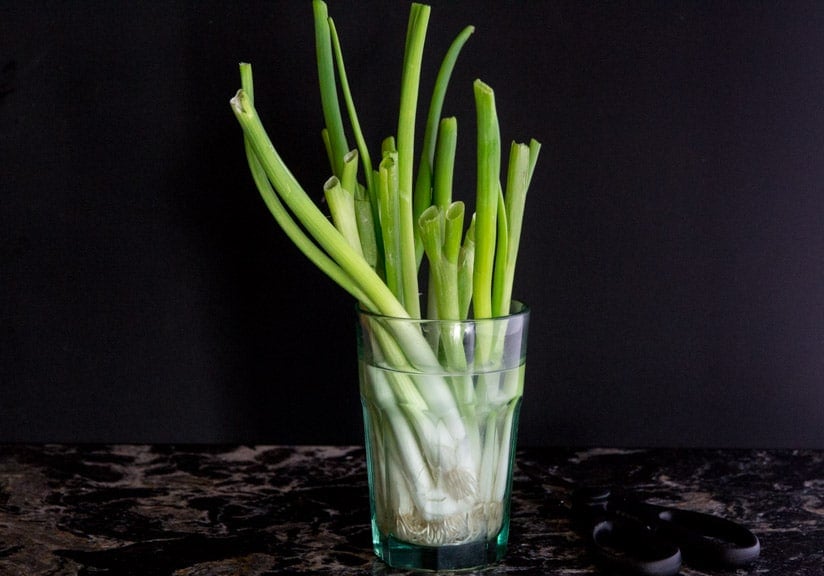
How Do I Use Scallion Bulb?
Use as you would white or yellow onion!
Where Do I Find Scallions and Green Onions, And How Do I Select Them?
Scallions can be found year-round in most grocery stores and at farmers markets in the summertime. They are also easy to grow, so that is a consideration. They come in bunches; choose ones with bright green, perky tops with no signs if wilting or flabbiness. The bulb should look plump and the roots at the end of the bulb should have no sliminess.
How Do You Store Green Onion Tops?
We don’t recommend that you do. We think scallion store best, whole. You can stand them up in a glass filled with about 1-inch (2.5 cm) of water, then cover the greens loosely with a plastic bag, or wrap in a damp (not wet) paper towel and store in vegetable drawer.
Separate the greens from the bulb right when you need them.
How Do You Re-Grow Green Onions?
It is easy to re-grow the green tops, once you have used them. We have full directions in our article, Grow Your Scallions In A Glass! It works for a while, but we do find that the greens are not quite the same as when first purchased and used. Planting, or replanting, in soil, which has more nutrients than water, often gives better results.
Chives & Asian Chives
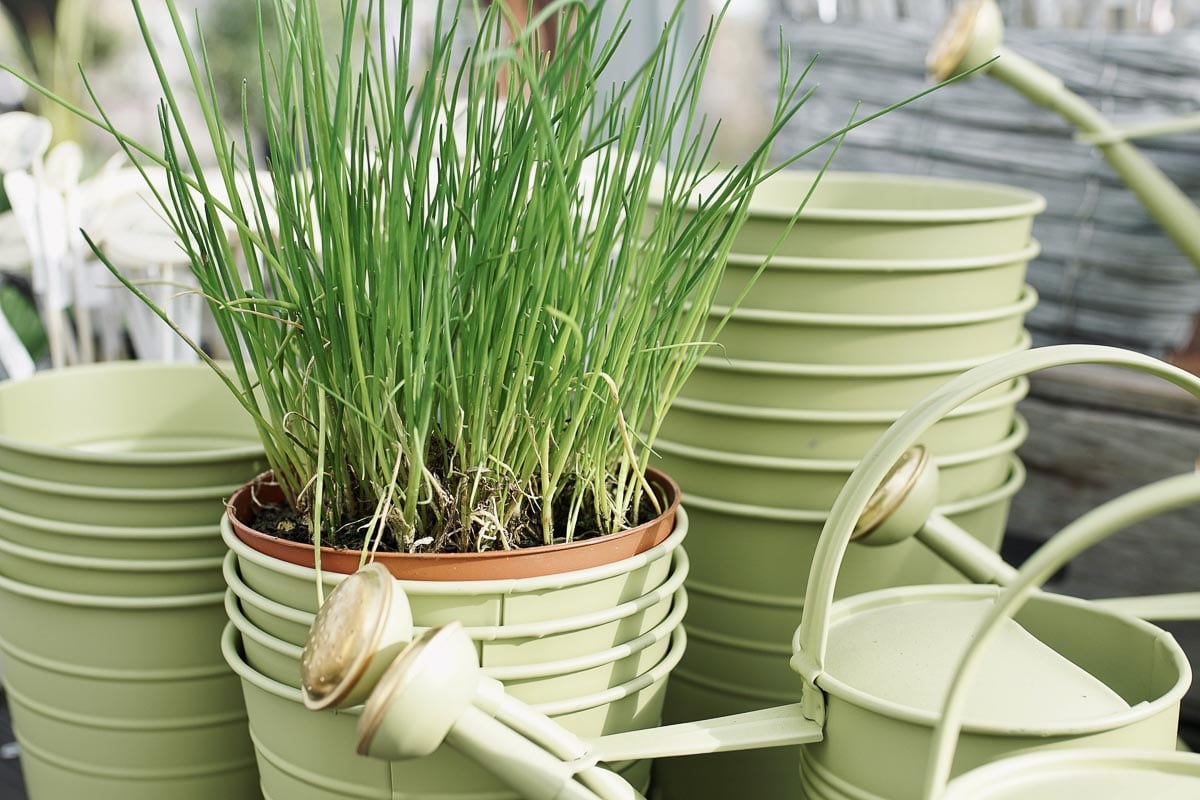
Are Chives Low FODMAP? Yes, chives are low FODMAP. Both Monash University and FODMAP Friendly have lab tested chives. In Monash University lab testing no FODMAPs were detected; their recommended serving size is 4 g. In FODMAP Friendly lab testing no FODMAPs were detected, either. Their recommended serving size is 4 g, with a suggested max serve of 1000 g (since removed from app).
Are Freeze-Dried Chives Low FODMAP?
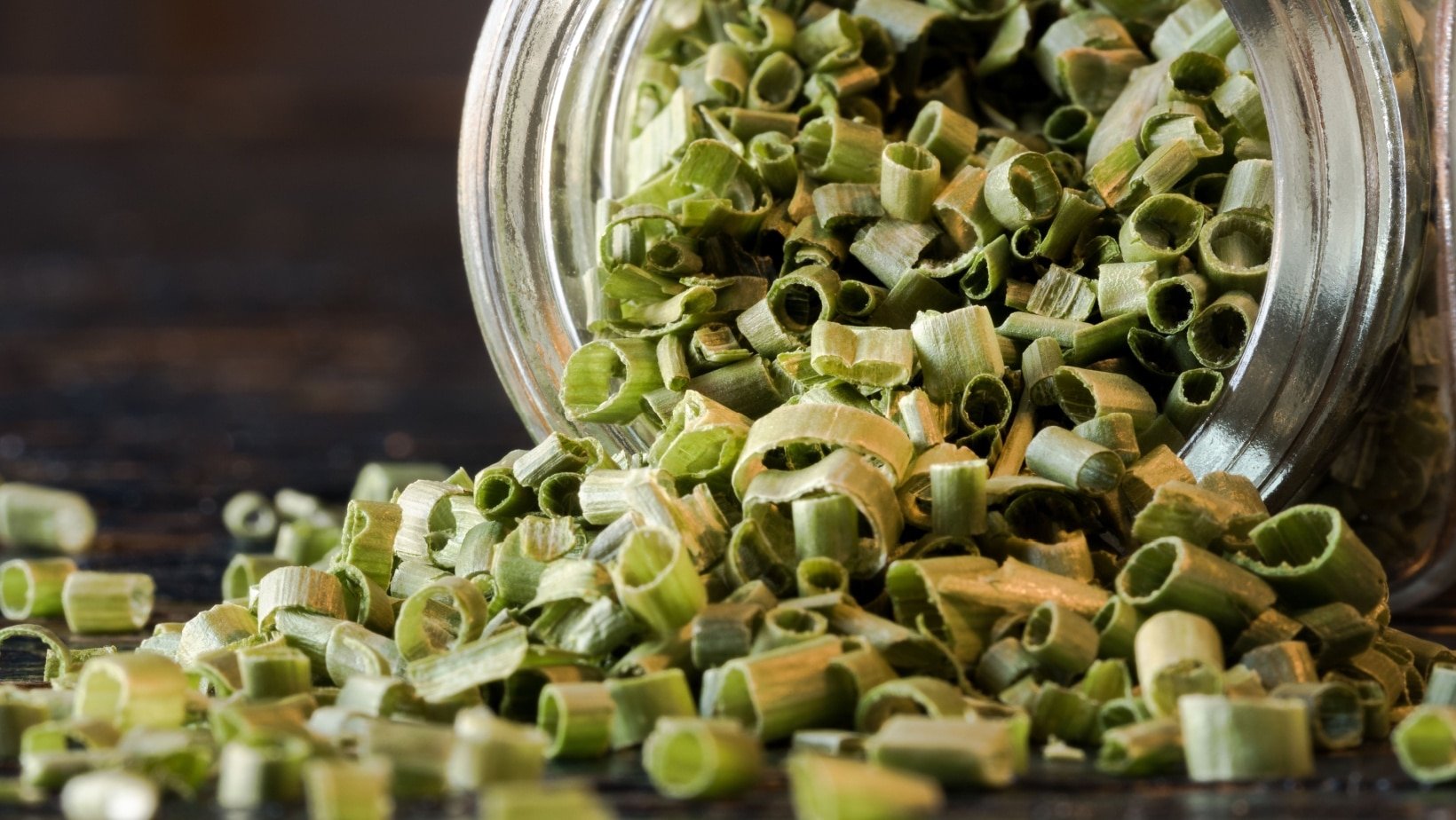
Did you know that it is easy to find freeze-dried chives in the herb and spice section of the supermarket? It is a way to have them always on hand, but are they low FODMAP?
Both Monash and FODMAP Friendly have also lab tested dried chives: the Monash serving size suggested is 2 g. FODMAP Friendly says eat freely; no FODMAPs detected.
How Do I Use Chives?
Chives have a subtle onion flavor and can be used raw or cooked any place you might want onion flavor. Check out our Low FODMAP Ranch Dressing for a great use of chives.
Where Do I Find Chives?
If available, chives will be in your produce section of the supermarket. They are also very easy to grow and as a perennial, will come up year after year, in the ground and they also make a great potted herb.
How Do I Store Chives?
If you have purchased them pre-packaged in a plastic blister-pack style container (very common in the U.S.) from the market, keep them in there and use up within a few days. If they are trimmed and fresh, roll up unwashed chives in a very lightly dampened paper towel and place in a plastic bag, which you will seal. Refrigerate for up to 1 week. Keep an eye on them. If they start wilting, use right away.
Are Asian Chives Low FODMAP? Are Garlic Chives Low FODMAP?
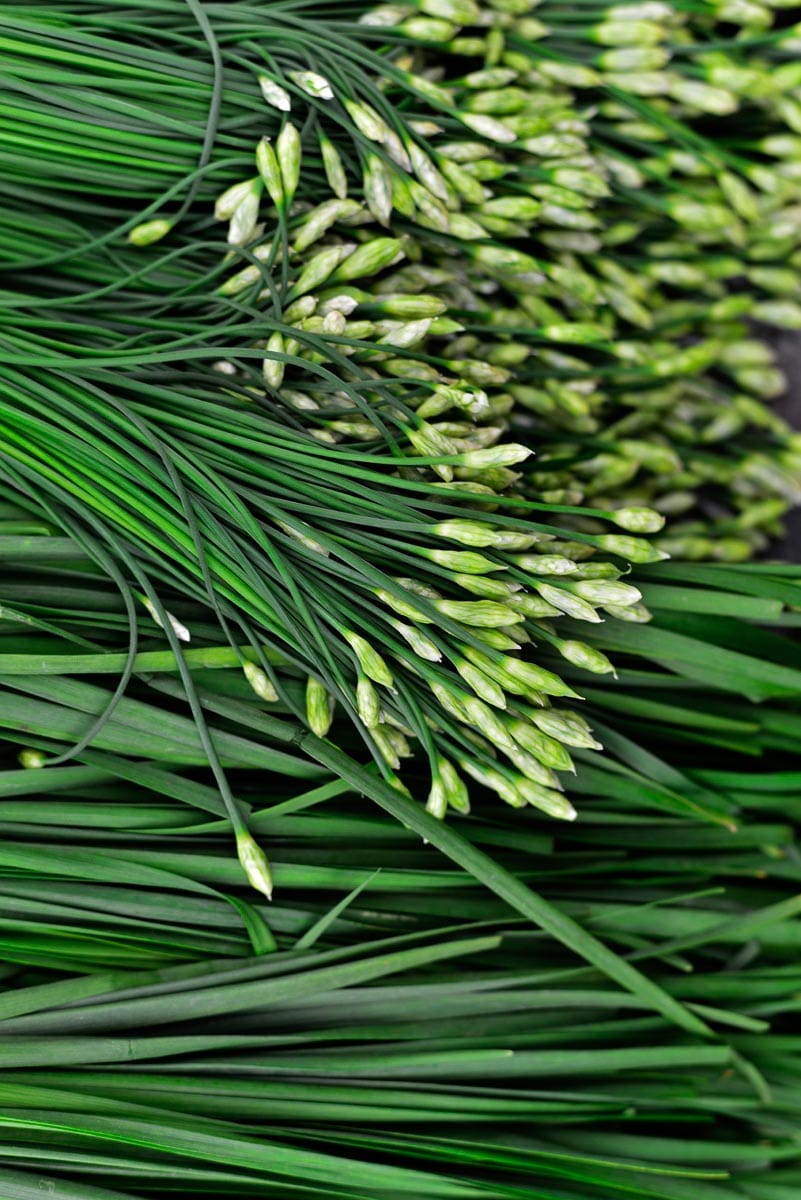
Yes, Asian chives are low FODMAP, and are sometimes called garlic chives. Monash University recommends an 80 g serving size; please note that their image does include the closed flower buds.
Asian chives, also called garlic chives, often have blossoms attached.
How Do I Use Asian Chives?
Asian chives have a subtle garlic flavor and can be used raw or cooked any place you might want garlic flavor. They usually come with a tight flower bud attached to the top and you can chop that along with the stem. Try them in a stir-fry.
Where Do I Find Asian Chives?
Of course, it will depend on where you live. For us we have to go to a store specializing in Asian ingredients that also has fresh produce.
How Do I Store Asian Chives?
In our markets they usually come trimmed away from their root and wrapped in plastic wrap. Refrigerated in the vegetable drawer, we usually get about 1 week out of them.
Leeks
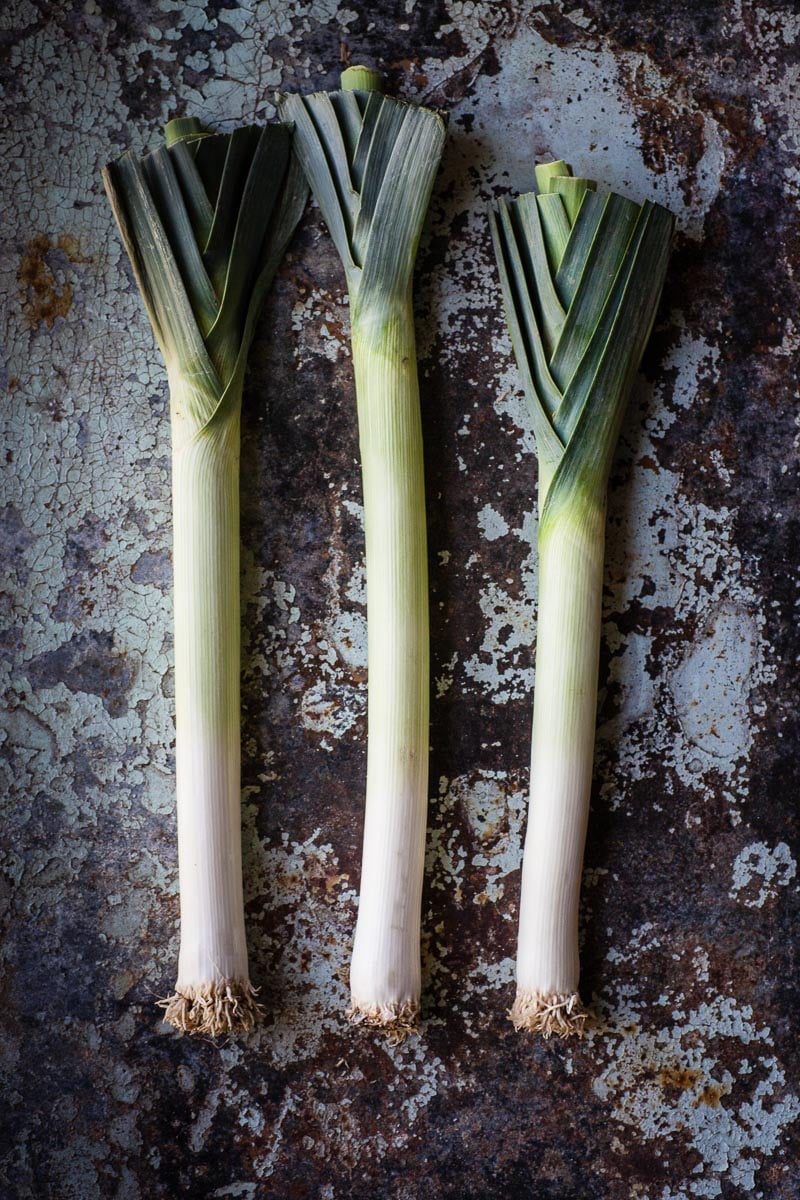
Leeks, Allium ampeloprasum var. porrum, look like big scallions and have a mild oniony flavor.
Are Leeks Low FODMAP?
Both Monash University and FODMAP Friendly have lab tested leeks – greens (leaves) and bulbs.
Monash University recommends a low FODMAP serving size of 100 g for the greens (updated to 75 g), and 14 g for the bulb. FODMAP Friendly suggests a serving size of leek greens of 37 g, with a low FODMAP max serve of 83 g; updated to 82 g. Their recommended max low FODMAP leek bulb amount is 46 g; updated to 47 g.
These leeks (shown above) have a medium amount of greens. Sometimes they have much less; sometimes more.
Where Can I Find Leeks And How Do I Select Them?
You can find fresh leeks in most supermarket produce sections, but, and this is a big caveat, some markets seem to stock them with lots of greens intact – great for us following the low FODMAP diet – and other markets have trimmed them all away. You will have to survey the markets close to you. You will have a better chance at finding them with greens attached at farmers markets.
The bulbs should be plump with no hint of sliminess or withering. The greens should be stiff, also with no signs of withering, browning or floppiness.
How Do I Prepare Leeks?
Wash the leeks well, and then dry. We have a photo for you below that shows where the leek greens and bulb portion meet. To chop the leaves, we suggest that you do so very finely, as they can be tough. As you get into the bulb portion there can be a lot of sandy dirt trapped within, so we usually halve the bulb lengthwise, or even quarter, and the dirt will be easier to see, then wash the dirt out.
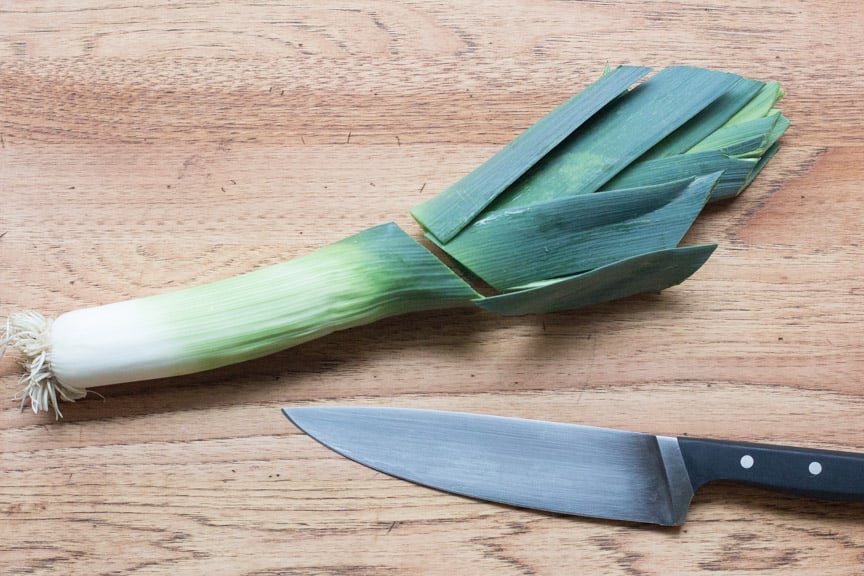
This is where we usually separate the greens from the rest of the leek.
How Do I Use Leek Leaves?
Once prepped – and we recommend very finely slicing and chopping the leek leaves – they are always cooked. While they could be eaten raw, they are so tough, it is never recommended. Use as you would white or yellow onion, sautéing first and using for soups, stews, braises, etc.
How Do I Use Leek Bulb?
Use as you would yellow or white onion, cooked or raw.
Ramps
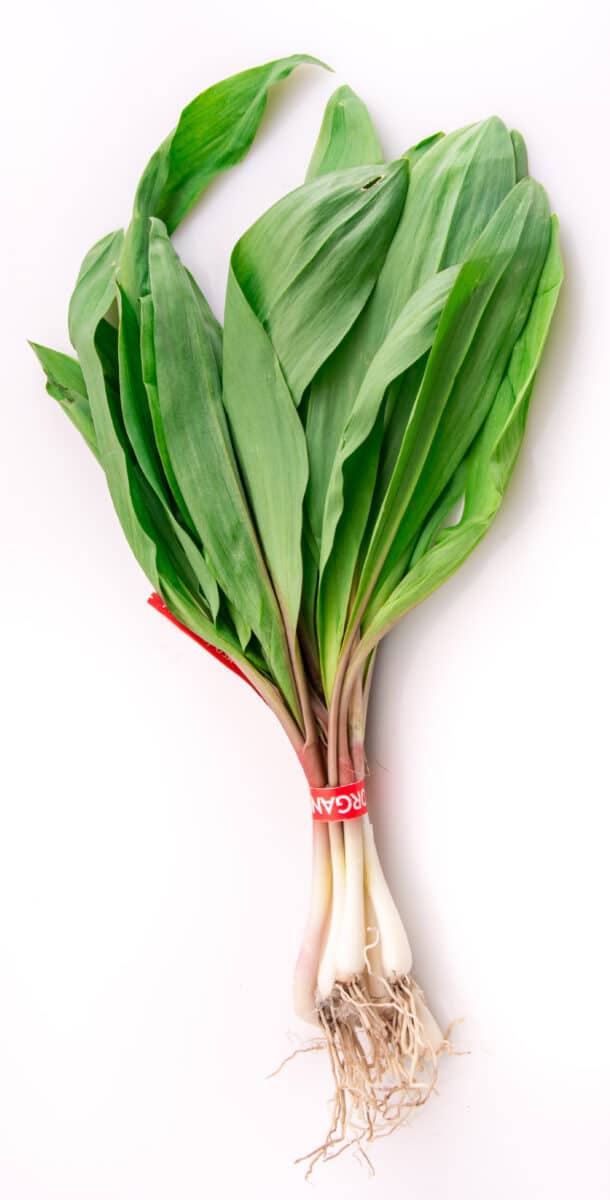
Ramps (Allium tricoccum) have not been lab tested for FODMAPs. They are wild onions native to North America with broad flat leaves, a purplish stem, and a slender bulb akin to a scallion, as seen below.
More On Garlic & Onions
If you are looking to learn more about garlic and onions, and their relationship to the low FODMAP diet, please check out the following:
- Low FODMAP Garlic & Onion Substitutes
- Not All Garlic-Infused Oil Is Low FODMAP
- Garlic-Infused Oil & The Low FODMAP Diet
- Get Your Garlic Fix on the Low FODMAP Diet
- Explore An Ingredient: Garlic
- Explore An Ingredient: Leeks
- Explore An Ingredient: Scallions
- All About Garlic Scapes and Garlic Chives
- Low FODMAP Garlic-Infused Oil
- Low FODMAP Onion-Infused Oil
- Low FODMAP Acidified Garlic Oil
- Know What’s In Your Garlic Oil
- Low FODMAP Aioli
The Takeaway
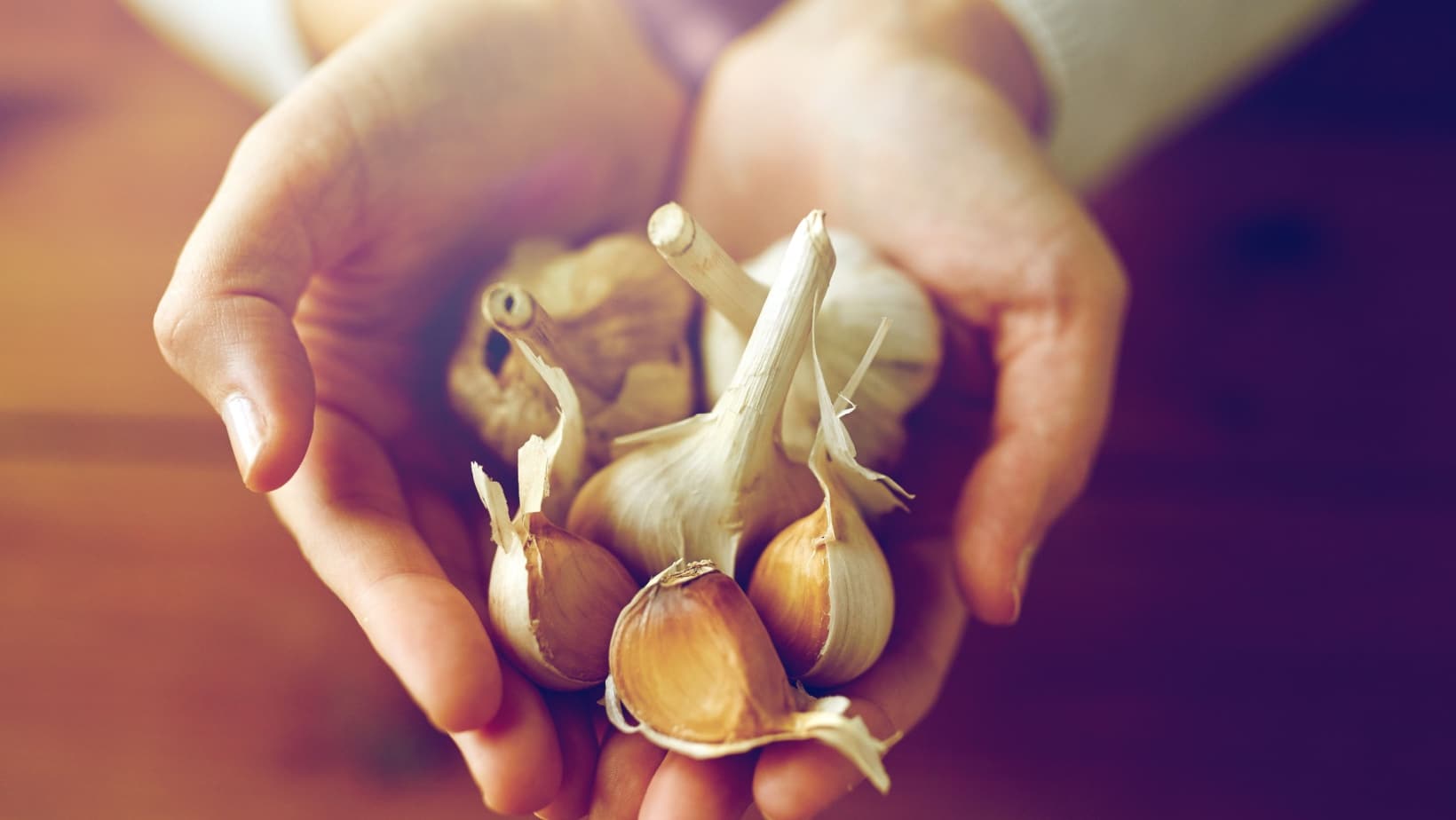
No need to go without garlic or onion flavor while following the low FODMAP diet, and in fact, there are many ways to incorporate certain amounts of actual garlic and onion (and various alliums) into your food, even during the most stringent Elimination Phase. Educate yourself to all of the fresh garlic and onion varieties items available.
We keep scallions growing on our windowsill all year round, and when we learned that the bulb was not completely off-limits, it opened up a world of cooking possibilities. Ditto for leek bulb.
Remember, the goal of the low FODMAP diet is to eventually eat as broadly as possible without triggering IBS symptoms. When you are in your Challenge Phase, be sure to try garlic, onions and all sorts of alliums in larger amounts to determine what your tolerance is. And if you cannot tolerate them right away, try Challenging yourself again several months down the line. More often than not, we see people being able to broaden their diet, even with these fructan-rich foods.

